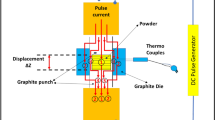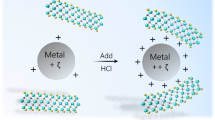Abstract
This article discusses methods for producing a material with gradient multilevel porosity by sintering layer-by-layer distributed α-Fe2O3 nanopowders and submicron powders. Nanopowders with an average particle size of 12 nm are obtained by coprecipitation and submicron powders in the form of hollow spheres are obtained by spray pyrolysis. The powders are consolidated by sintering in a muffle furnace, by hot pressing, and by spark plasma sintering (SPS) at various temperatures, loads, and holding times. It has been demonstrated that sintering in a muffle furnace and hot pressing do not allow one to obtain a compact sample of sufficient strength due to various activity of nano- and submicron powders. SPS produced powdered materials at holding temperatures of 700, 750, 800, and 900°C in 3 min. It has been established that a series of powders produced by SPS at 750°C is characterized by sufficient strength and an open porosity of 20% upon a total porosity of 37%. An increase in temperature in the frames of SPS leads to an increase in particle size in the bulk of nanopowders to the micron range and the partial destruction of hollow submicron spheres. While studying the phase composition of the produced samples, it has been revealed that it is identical to that of the initial powders. However, in the series of samples produced by hot pressing and SPS, the growth of crystals is observed in the bulk of nanopowders in the [001] direction of the highest electric and heat conductance along the punch axes. This is related with the temperature gradient between the bulk of nanopowders and punches and the lowest surface energy of plane (110), including the [001] direction.










Similar content being viewed by others
Notes
Hereinafter, the sintering temperature is presented by the temperature on the surface of a graphite matrix.
REFERENCES
Liang Feng-Xia, Liang Lin, Zhao Xing-Yuan, Tong Xiao-Wei, Hu Ji-Gang, Lin Yi, Luo Lin-Bao, and Wu Yu-Cheng, Mesoporous anodic α-Fe2O3 interferometer for organic vapor sensing application, R. Soc. Chem. Adv., 2018, vol. 8, no. 54, pp. 31121–31128. https://doi.org/10.1039/C8RA06261G
Hakim, A., Marliza, T.S., Abu Tahari, M.N., Yusop, M.R., Mohamed Hisham, M.W., and Yarmo, M.A., Development of α-Fe2O3 as adsorbent and its effect on CO2 capture, Mater. Sci. Forum, 2016, vol. 840, pp. 421–426. https://doi.org/10.4028/www.scientific.net/msf.840.421
Prasad, B., Ghosh, C., Chakraborty, A., Bandyopadhyay, N., and Ray, R.K., Adsorption of arsenite (As3+) on nano-sized Fe2O3 waste powder from the steel industry, Desalination, 2011, vol. 274, pp. 105–112. https://doi.org/10.1016/j.desal.2011.01.081
Qiu, M., Wang, R., and Qi, X., Hollow polyhedral α‑Fe2O3 prepared by self-assembly and its photocatalytic activities in degradation of RhB, J. Taiwan Inst. Chem. Eng., 2019, vol. 102, pp. 394–402. https://doi.org/10.1016/j.jtice.2019.05.024
Xiao, C., Li, J., and Zhang, G., Synthesis of stable burger-like α-Fe2O3 catalysts: Formation mechanism and excellent photo-Fenton catalytic performance, J. Cleaner Prod., 2018, vol. 180, pp. 550–559. https://doi.org/10.1016/j.jclepro.2018.01.127
Pengwei Yan, Jimin Shen, Lei Yuan, Jing Kang, Binyuan Wang, Shengxin Zhao, and Zhonglin Chen, Catalytic ozonation by Si-doped α-Fe2O3 for the removal of nitrobenzene in aqueous solution, Sep. Purif. Technol., 2019, vol. 228, p. 115766. https://doi.org/10.1016/j.seppur.2019.115766
Rani, B.J., Kumar, M.P., Ravi, G., Ravichandran, S., Guduru, R.K., and Yuvakkumar, R., Electrochemical and photoelectrochemical water oxidation of solvothermally synthesized Zr-doped α-Fe2O3 nanostructures, Appl. Surf. Sci., 2019, vol. 471, pp. 733–744. https://doi.org/10.1016/j.apsusc.2018.12.061
Arzaee, N.A., Noh, M.F.M., Ab Halim, A., Rahim, M.A., Mohamed, N.A., Safaei, J., Aadenan, A., Nasir, S.N.S., Ismail, A.F., and Teridi, M.A.M., Aerosol-assisted chemical vapor deposition of α-Fe2O3 nanoflowers for photoelectrochemical water splitting, Ceram. Int., 2019, vol. 45, pp. 16797–16802. https://doi.org/10.1016/j.ceramint.2019.05.219
Reddy, I.N., Reddy, Ch.V., Sreedhar, A., Cho, M., Kim, D., and Shim, J., Effect of plasmonic Ag nanowires on the photocatalytic activity of Cu doped Fe2O3 nanostructures photoanodes for superior photoelectrochemical water splitting applications, J. Electroanal. Chem., 2019, vol. 842, pp. 146–160. https://doi.org/10.1016/j.jelechem.2019.04.076
Fogliatto, A.A.B., Ahrens, C.H., Wendhausen, P.A.P., Santos, E.C., and Rodrigues, D., Correlation between porosity and permeability of stainless steel filters with gradient porosity produced by SLS/SLM, Rapid Prototyping J., 2020, vol. 26, no. 1, pp. 73–81. https://doi.org/10.1108/RPJ-09-2018-0224
Hua Cheng, Lingxia Zheng, Chun Kwan Tsang, Jie Zhang, Wang, H.E., Yucheng Dong, Hui Li, Fengxia Liang, Zapien, J.A., and Yang Yang Li, Electrochemical fabrication and optical properties of periodically structured porous Fe2O3 films, Electrochem. Commun., 2012, vol. 20, pp. 178–181. https://doi.org/10.1016/j.elecom.2012.05.007
Zhai Song, Ye Jia-Ru, Wang Nan, Jiang Lin-Hai, and Shen Qing, Fabrication of porous film with controlled pore size and wettability by electric breath figure method, J. Mater. Chem. C, 2014, vol. 2, pp. 7168–7172. https://doi.org/10.1039/C4TC01271B
Žic, M., Ristić, M., and Musić, S., Monitoring the hydrothermal precipitation of α-Fe2O3 from concentrated Fe(NO3)3 solutions partially neutralized with NaOH, J. Mol. Struct., 2011, vol. 993, pp. 115–119. https://doi.org/10.1016/j.molstruc.2010.09.048
Kargin, J., Mukhambetov, D., Kozlovskiy, A., and Biseken, A., Hollow hematite particles synthesized by spray pyrolysis of the spent pickling solution, Sci. Eur., 2017, vol. 18, no. 2, pp. 78–80.
Ardekani, S.R., Aghdam, A.S.R., Nazari, M., Bayat, A., Yazdani, E., and Saievar-Iraniza, E., A comprehensive review on ultrasonic spray pyrolysis technique: Mechanism, main parameters and applications in condensed matter, J. Anal. Appl. Pyrolysis, 2019, vol. 141, p. 104631. https://doi.org/10.1016/j.jaap.2019.104631
Kocjan, A., Logar, M., and Shen, Z., The agglomeration, coalescence and sliding of nanoparticles, leading to the rapid sintering of zirconia nanoceramics, Sci. Rep., 2020, vol. 7, p. 2541. https://doi.org/10.1038/s41598-017-02760-7
Ponomarev, M.A. and Loryan, V.E., Synthesis of materials of different porosity from mixtures of aluminum, boron and titanium fine powders and large granules of VT6 alloy, Proc. Int. Conference “Synthesis and Consolidation of Powder Materials”, Chernogolovka, 2018, pp. 94–99. https://doi.org/10.30826/SCPM2018018
Chuvil’deev, V.N., Blagoveshchenskii, Yu.V., Boldin, M.S., Moskvicheva, A.V., Sakharov, N.V., Nokhrin, A.V., Isaeva, N.V., Shotin, S.V., Lopatin, Yu.G., Pisklov, A.V., and Kotkov, D.N., High-speed electropulse plasma sintering of nanostructured tungsten carbide: Part 1. Experiment, Russ. J. Non-Ferrous Met., 2014, vol. 55, no. 6, pp. 592–598. https://doi.org/10.3103/S1067821214060066
Supattarasakda, K., Petcharoen, K., Permpool, T., Sirivat, A., and Lerdwijitjarud, W., Control of hematite nanoparticle size and shape by the chemical precipitation method, Powder Technol., 2013, vol. 249, pp. 353–359.
Nidhi, S., Nasimul, S., and Bankim, R., Fundamentals of spark plasma sintering (SPS): An ideal processing technique for fabrication of metal matrix nanocomposites, in Advances in Processing and Applications, Cham: Springer, 2019. https://doi.org/10.1007/978-3-030-05327-7
Chaim, R., Electric field effects during spark plasma sintering of ceramic nanoparticles, J. Mater. Sci., 2013, vol. 48, pp. 502–510. https://doi.org/10.1007/s10853-012-6764-9
Warnes, B.M., Aplan, F.F., and Simkovich, G., Electrical conductivity and seebeck voltage of Fe2O3, pure and doped, as a function of temperature and oxygen pressure, Solid State Ionics, 1984, vol. 12, pp. 271–276. https://doi.org/10.1016/0167-2738(84)90156-5
Seki, M., Takahashi, M., Ohshima, T., Yamahara, H., and Tabata, H., Solid-liquid-type solar cell based on α‑Fe2O3 heterostructures for solar energy harvesting, Jpn. J. Appl. Phys., 2014, vol. 53, no. 5S1, p. 05FA07. https://doi.org/10.7567/jjap.53.05fa07
Manière, C., Durand, L., Brisson, E., Desplats, H., Carré, P., Rogeon, Ph., and Estournès, C., Contact resistances in spark plasma sintering: From in-situ and ex-situ determinations to an extended model for the scale up of the process, J. Eur. Ceram. Soc., 2017, vol. 37, pp. 1593–1605. https://doi.org/10.1016/j.jeurceramsoc.2016.12.010
Patra Astam K., Kundu Sudipta K., Bhaumik Asim, and Kim Dukjoon, Morphology evolution of single-crystalline hematite nanocrystals: magnetically recoverable nanocatalysts for enhanced facet-driven photoredox activity, R. Soc. Chem., 2016, vol. 8, pp. 365–377. https://doi.org/10.1039/C5NR06509G
Smith, D., Alzina, A., Bourret, J., Nait-Ali, B., Pennec, F., Tessier-Doyen, N., and Gonzenbach, U., Thermal conductivity of porous materials, J. Mater. Res., 2013, vol. 28, pp. 2260–2272. https://doi.org/10.1557/jmr.2013.179
Funding
This work was supported by the Russian Foundation for Basic Research, project no. 20-38-90166.
Author information
Authors and Affiliations
Corresponding authors
Additional information
Translated by I. Moshkin
About this article
Cite this article
Demirov, A.P., Blinkov, I.V., Kuznetsov, D.V. et al. Production of Powdered α-Fe2O3 with Multilevel Gradient Porosity. Russ. J. Non-ferrous Metals 62, 602–610 (2021). https://doi.org/10.3103/S1067821221050035
Received:
Revised:
Accepted:
Published:
Issue Date:
DOI: https://doi.org/10.3103/S1067821221050035




